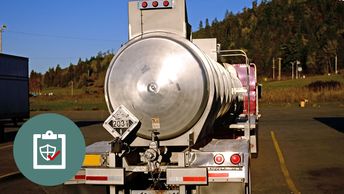DOT: Reasonable Suspicion (Drug and Alcohol Awareness)
- 20 topics | 2h 10m 1s
- Up to 30 languages
- Transcripts
Drug and alcohol abuse by employees is a common cause of serious workplace problems faced by American companies and organizations today, including accidents and ineffective work practices. Beyond the financial burden of increased insurance costs, loss of income, and compensation payments, substance use on the job can result in life-changing injuries or fatalities. Several US laws have been enacted to combat drug and alcohol abuse in the workplace. The Department of Transportation (DOT) interprets these laws and provides employers who are responsible for transportation employees with guidelines for setting up effective drug-free programs. Employers rely on supervisors to implement these guidelines; for example, through being vigilant in identifying and addressing instances of workplace substance abuse and alcohol misuse. In particular, supervisors of safety-sensitive employees must monitor staff members to determine whether or not there are sufficient grounds to refer the individuals for a reasonable-suspicion drug or alcohol test, and then follow the required testing procedures. This course explores the causes, indicators, and consequences of alcohol misuse and substance abuse in the US transportation industry. It describes the US laws that relate to drug and alcohol testing of transportation employees and outlines DOT regulations that enforce compliance among transportation employers. The course also discusses the supervisor's role in referring employees for testing based on a reasonable suspicion that a safety-sensitive worker is using or under the influence of alcohol or drugs while on duty. DOT Federal Motor Carrier Safety Administration regulation 49 CFR Part 382.603 (Alcohol Misuse and Controlled Substances Use Information, Training, and Referral - Training for supervisors) requires supervisors of commercial motor vehicle drivers who operate vehicles that require a commercial driver license to take 60 minutes of training on alcohol misuse and 60 minutes of training on controlled substances use. This course is designed to meet the requirements of 49 CFR Part 382.603. This course was developed with subject matter support provided by EnSafe Inc., a global professional services company focusing on engineering, environment, health and safety, and information technology. Please note, the course materials and content were current with the laws and regulations at the time of the last expert review, however, they may not reflect the most current legal developments. Nothing herein, or in the course materials, shall be construed as professional advice as to any particular situation with respect to compliance with legal statutes or requirements.
WHAT YOU WILL LEARN
-
identify types of dependency that can result from substance abuse
-
identify physical and behavioral symptoms of alcohol use
-
recognize physical and behavioral symptoms of amphetamine use
-
identify behavioral and physical symptoms indicative of cocaine use
-
recognize physical and behavioral symptoms of being under the influence of marijuana
-
identify behavioral and physical symptoms of opiate use
-
recognize physical and behavioral symptoms associated with phencyclidine (PCP)
-
identify potential consequences of workplace substance abuse for employers and employees
-
identify requirements for compliance under the Drug-Free Workplace Act of 1988
-
identify guidelines supervisors should encourage employees to follow when they notice substance abuse problems at work
-
identify the elements of a successful drug-free workplace program
-
identify procedural guidelines specified in 49 CFR Part 40, Procedures for Transportation Workplace Drug and Alcohol Testing Programs
-
identify categories of transportation employees described as safety sensitive by the DOT
-
identify service agents who do not need employee consent to perform saliva or breath alcohol tests
-
recognize circumstances under which drug and alcohol testing is required for safety-sensitive employees
-
recognize reasonable suspicion testing requirements
-
identify guidelines supervisors should follow when conducting a reasonable suspicion interview
-
sequence the steps in a DOT-compliant drug testing procedure
-
identify DOT-approved alcohol tests
-
identify the recommended steps an employer should take when drug and alcohol test results are positive
IN THIS COURSE
-
Introducing Workplace Substance Abuse7m
-
Recognizing Problematic Use of Legal Substances7m
-
Distinguishing Workplace Amphetamine Use4m
-
Identifying Key Indicators of Cocaine Use4m
-
Understanding the Effects of Marijuana Use5m
-
Recognizing the Use of Opiates in the Workplace4m
-
Monitoring for Signs of PCP Use4m
-
Recognizing the Impact of Workplace Substance Abuse5m
-
Complying with the Drug-Free Workplace Act of 19885m
-
Identifying Characteristics of Substance Abuse4m
-
Maintaining a Substance-free Workplace4m
-
Following the DOT Guidelines4m
-
Identifying DOT-regulated Employees11m
-
Meeting Drug & Alcohol Testing Privacy Requirements5m
-
Determining When Drug & Alcohol Testing is Required6m
-
Adhering to Reasonable Suspicion Test Requirements9m
-
Conducting a Reasonable Suspicion Interview8m
-
Testing for Illegal Substance Use11m
-
Performing DOT-approved Alcohol Tests7m
-
Responding to Positive Test Results5m
YOU MIGHT ALSO LIKE
COMPLIANCE-COURSE
DOT: Cross-border Requirements (US and Canada)
COMPLIANCE-COURSE
DOT General Awareness
COMPLIANCE-COURSE
DOT: CSA Fundamentals


